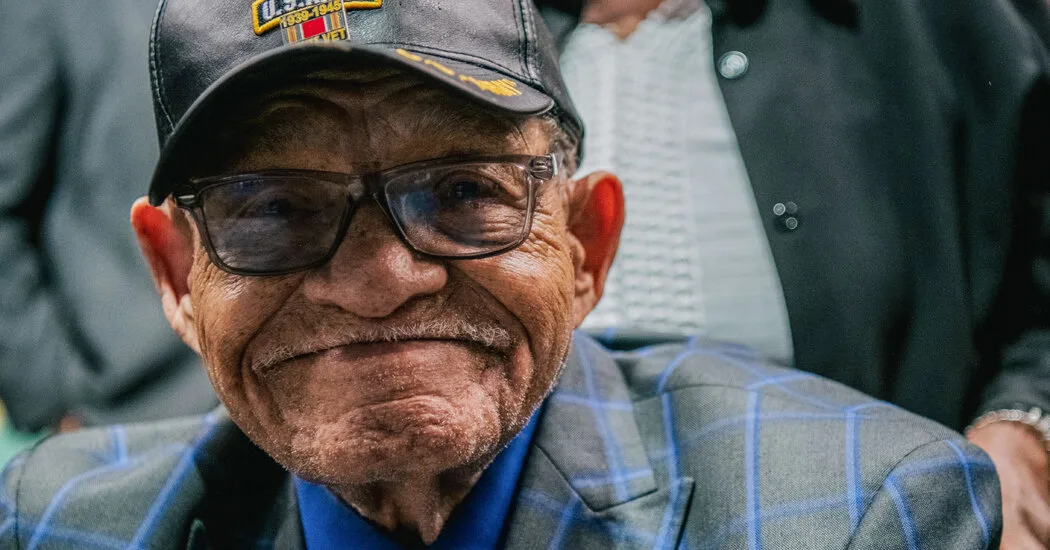
Mr. Ellis was one of three known remaining survivors of the massacre, in which a white mob burned down the Greenwood district of Tulsa, Okla., killing as many as 300 Black residents.
Hughes Van Ellis, one of three known remaining survivors of the 1921 massacre in which a heavily armed white mob killed hundreds of Black residents in Tulsa, Okla., died on Monday in Denver. He was 102.
His death, at a veterans’ hospital, was confirmed by his daughter Muriel Ellis Watson, who said in a telephone interview that her father had been receiving treatment for cancer that had recently spread to his brain.
With his death, only Lessie Benningfield Randle, 108, and Mr. Ellis’s sister Viola Ford Fletcher, 109, remain as the last known survivors of the massacre. The mob killed hundreds of Black residents and burned much of Tulsa’s prosperous, largely African American Greenwood neighborhood to the ground in one of the worst racist terror attacks in U.S. history.
On May 31, 1921, a Black man, Dick Rowland, was accused of sexually assaulting a white woman in an elevator in downtown Tulsa. After he was jailed, a group of armed Black people, fearful he would be lynched, gathered outside the county courthouse to ensure his safety.
Hundreds of white residents of Tulsa called on the sheriff to turn Mr. Rowland over and, according to a 2001 report by the Oklahoma Commission to Study the Tulsa Race Riot of 1921, a Black man’s gun went off when a white man tried to grab it.
The white mob spread out through downtown Tulsa, shooting Black people on sight and setting fire to businesses in Greenwood. The destruction eradicated a thriving district known as Black Wall Street, where Black entrepreneurs owned and ran restaurants, hotels, theaters and other businesses.
As many as 300 Black people were killed and more than 1,200 homes were destroyed.
The charges against Mr. Rowland were eventually dropped. The authorities concluded that he had most likely tripped and stepped on the woman’s foot, the commission report said.
In 2020, Mr. Ellis, Ms. Fletcher and Ms. Randle joined descendants of other victims of the massacre in filing a lawsuit seeking reparations for the losses they endured. Seven defendants were named in the lawsuit, including the city of Tulsa, the Tulsa County Sheriff’s Office, the Oklahoma National Guard and the city’s Chamber of Commerce.
A judge ruled in May 2022 that part of the case could proceed. It was dismissed in July 2023, but the state’s high court agreed in August to hear an appeal.
Damario Solomon-Simmons, a lawyer for the plaintiffs, said in a telephone interview that he filed additional arguments in court on Tuesday, and emphasized the urgency of the matter, given the ages of the remaining plaintiffs.
“We’re in a race against time,” he added in a statement. “Neither the city of Tulsa nor the Tulsa County judicial system should be allowed to keep moving the finish line for the remaining survivors who have been fighting with their final breaths just to get their day in court.”
Hughes Van Ellis was born in Holdenville, Okla., on Jan. 11, 1921. He was not yet 5 months old at the time of the massacre, after which his parents fled Tulsa with their six children, leaving their home and possessions, Ms. Watson said. The family grew to eight children.
“Because of the massacre, my family was driven out of our home,” Mr. Ellis told members of a House Judiciary subcommittee in May 2021. “We were left with nothing. We were made refugees in our own country.”
He was drafted and served in an all-Black combat unit in World War II, Ms. Watson said. He and his wife, Mable V. Ellis, were married in 1942, eventually settling in Oklahoma City.
Mr. Ellis worked as a sharecropper and as a mechanic at what is now Tinker Air Force Base, Ms. Watson said. He also worked as a janitor, a gardener and a gas station attendant, his daughter said. He and his wife had seven children and settled in Denver. Ms. Ellis died in 2011.
In addition to his sister and Ms. Watson, Mr. Ellis’s survivors include another daughter, Malee V. Craft.
After the Tulsa Race Massacre, officials set about erasing it from the city’s historical record. Victims were buried in unmarked graves. Police records vanished. Newspaper articles about it were removed before the pages were transferred to microfilm. Schools in Oklahoma weren’t instructed to teach students about it until 2002.
Mr. Ellis and the other survivors carried the experience of the massacre with them past age 100 as they sought reparations and a measure of justice.
“The Tulsa Race Massacre isn’t a footnote in a history book for us,” Mr. Ellis told the House subcommittee in 2021. “We live with it every day, and the thought of what Greenwood was and what it could have been.”
“We aren’t just black-and-white pictures on a screen,” he added. “We are flesh and blood. I was there when it happened. I’m still here.”


